 Jane Buyers, History Lesson #9: The Order of Things, 1996; Graphite on toned paper, 127.2 x 173.9 cm; Kitchener-Waterloo Art Gallery Collection. Gift of the artist, 2000. Photo: Robert McNair.
Jane Buyers, History Lesson #9: The Order of Things, 1996; Graphite on toned paper, 127.2 x 173.9 cm; Kitchener-Waterloo Art Gallery Collection. Gift of the artist, 2000. Photo: Robert McNair.
Strange to think of books as art, or the conjunction of words and letters (dry, pure signs) and paint and image, but here at NC it seems to be a running motif. Herewith a lovely essay from Contributing Editor Ann Ireland about a recent visit to the Kitchener-Waterloo Art Gallery and the home of artist Jane Buyers and her musician/playwright partner Don Druick who live in Mennonite country in nearby Elmira, Ontario, and, Lo! we find artful annotations and a porcelain book amid other gorgeous works. Also baked bread from a Virginia Woolf recipe and baroque music and, well, you know, pretty soon you want to move there because you are reminded that in this violent, frenetic world of post recession economics and grinding little wars — trouble, trouble everywhere — there are actually people who live the life of the mind and art.
dg
 Jane Buyers: Photo by Ann Ireland
Jane Buyers: Photo by Ann Ireland
§
I feel like the Friendly Giant leaning down to peer into the miniature studio with its pint-sized furniture and tiny tools hanging on the wall. It looks like the mini-artist just stepped out of the room, leaving the drafting table with a rough sketch laid out and papers flung beneath. The multi-paned windows give me a shake of memory – they are south facing, if I recall correctly.
This is – or was – Jane Buyers’ studio in downtown Toronto, circa 1976, replicated inside this cube about the size of a breadbox. I lived on the other side of that wall with my artist boyfriend, Tim Deverell. There was a toilet down the hall and a retired sea captain who lived upstairs in the building, along with various spectral figures that would come and go at all hours.
This piece, part of a survey of the work of artist Jane Buyers at the Kitchener-Waterloo Art Gallery this winter, features an audio component. I place headphones over my ears and listen to a recording of German artist, Joseph Beuys, intoning T. S. Eliot.
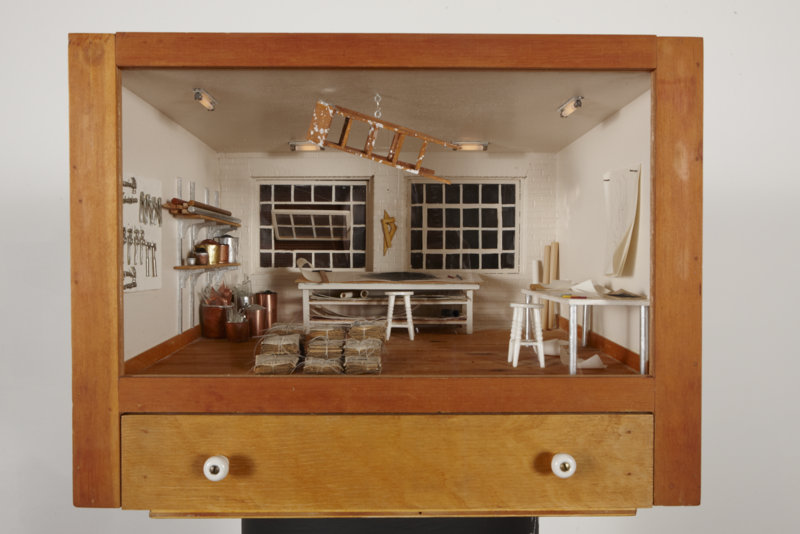 Jane Buyers, Che Fare -What is to be Done (detail), 1983. Wood, paper, copper, glass, audio, electric lights, text. 154.5 cm x 49 cm x 40 cm. Photo credit: Laura Arsie.
Jane Buyers, Che Fare -What is to be Done (detail), 1983. Wood, paper, copper, glass, audio, electric lights, text. 154.5 cm x 49 cm x 40 cm. Photo credit: Laura Arsie.
Jane Buyers works with memory, a rescue mission using discarded artifacts and tools, as well as images from places that have been deserted. In this major survey of thirty years of work called Gather…Arrange…Maintain,{{1}}[[1]]See video of the exhibition with commentary by Jane Buyers at the bottom of the essay.[[1]] traces of tools have been reconstituted, sometimes scrupulously drawn in graphite on paper, sometimes fashioned into porcelain– in each case, transformed from the dustbin into something unexpected. Buyers catches our eye with the old made new: in a carefully rendered drawing of a pair of pliers the object’s utilitarian past slips away; this is not your dad outlining his tools on the wall of the basement workshop. Jane literally ‘draws’ old objects to our attention.
At one end of the gallery, huge graphite drawings of a series called Book of Hours contain images of flowers and other botanicals taken from textiles and bolts of wallpaper from generations past. The pieces play off ideas of what is decorative, or used to be considered so. I think of some ancient aunt’s curtains or upholstered furniture. The drawings are painstaking in execution and Buyers admits to a kind of ‘devotion’ in the focused labour of making them.
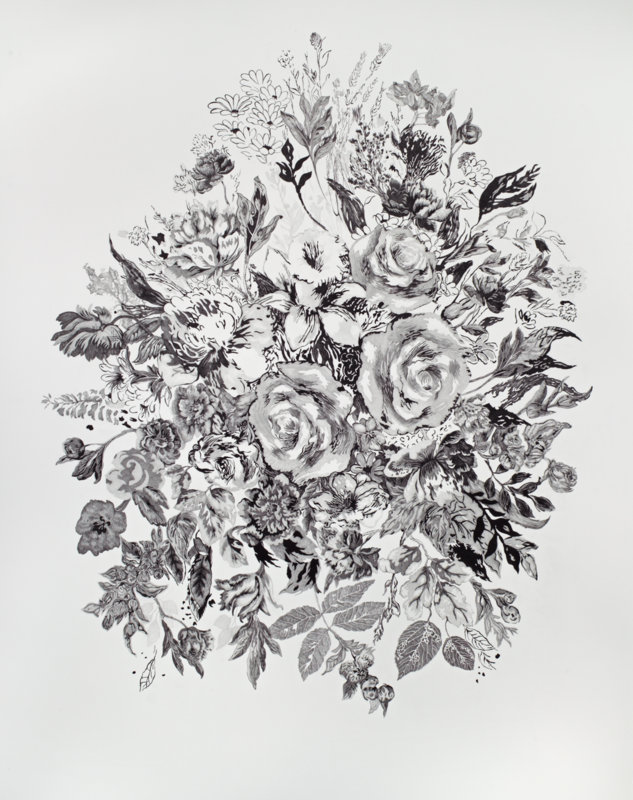 Jane Buyers, Book of Hours lV, 2010. Graphite on paper. 183 x 137 cm. Photo credit: Robert McNair.
Jane Buyers, Book of Hours lV, 2010. Graphite on paper. 183 x 137 cm. Photo credit: Robert McNair.
She’s partial to collecting old schoolbooks containing poetry and Shakespeare plays, the text underlined and annotated. Buyers tells me: ‘The student’s handwriting is so uncertain and you feel the tremendous desire to understand. I like the anxiety and striving to grasp the meaning of the printed word.’ In one of her pieces, a black rose is planted over the scrawled notes of some long ago student struggling with the text of Macbeth.
 Jane Buyers, Notes on Macbeth: Enter Lady Macbeth, 2004. Lithograph, etching, chine colle. 81.5 x 102 cm. Photo credit: Laura Arsie.
Jane Buyers, Notes on Macbeth: Enter Lady Macbeth, 2004. Lithograph, etching, chine colle. 81.5 x 102 cm. Photo credit: Laura Arsie.
Books feel like an endangered species these days. So it is startling to see Inscriptions, a series of delicate sculptures made of porcelain. They are books flung open, some embedded with porcelain leaves- the sort of leaves that fall from trees. Organic matter meets the pulped paper – except the materials have become impossibly fragile. Their vulnerability creates a hushed feeling in the viewer. I tip toe past, wary of creating a stiff breeze.
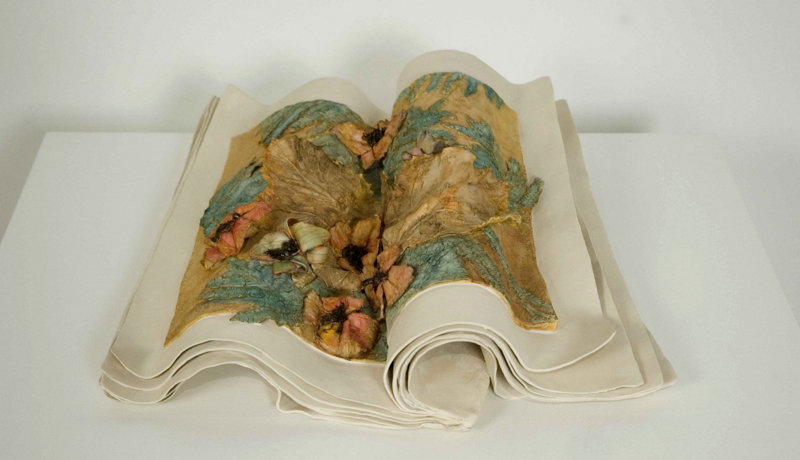 Jane Buyers, Inscriptions #19, 2005. Porcelain, 50 x 47 x 15 cm. Photo credit: Cheryl O’Brien.
Jane Buyers, Inscriptions #19, 2005. Porcelain, 50 x 47 x 15 cm. Photo credit: Cheryl O’Brien.
Buyers’ work is painstaking in process, requiring long hours in the studio. The result causes this high degree of attentiveness in the viewer. The eye slows down, is seduced by detail.
Tim and I have come to view the show and to visit Jane and her partner – award-winning playwright/musician/composer Don Druick at their home in Elmira, Ontario – a stone’s throw from Kitchener. It’s Mennonite country. En route between gallery and their house, driving along the New Jerusalem road, we spot horse -drawn carriages clipping along the edge of the highway, chilly Mennonites crouched in the back. It’s snowing lightly. Mennonites eschew electricity and driving cars. They sew their own plain, boxy clothing. During the growing season, Don and Jane visit nearby farms to buy produce plucked an hour earlier, dirt clinging to the gnarly carrots and sturdy lettuce.
Tim and I are city mice visiting the country mice – Elmira, population 10,000, being solidly rustic to our downtown Toronto eyes. The old yellow brick house is part of a former farm, and the garage has been fitted out as Jane’s studio. Several pairs of gumboots sit on the welcome mat of the house.
 Jane Buyers,Chronicles #6, 2005. Etching with graphite drawing. 67.5 x 86.5 cm. Photo credit: Laura Arsie.
Jane Buyers,Chronicles #6, 2005. Etching with graphite drawing. 67.5 x 86.5 cm. Photo credit: Laura Arsie.
Don used to perform and compose avant garde music. I remember his visits to the Western Front, an artists’ exhibition/event space in Vancouver, back when I was a student in the 1970‘s. I thought he looked like a faun, stepping lightly across the stage, hair dyed platinum blonde, silver flute held to his lips.
We’re all a bit less faun-like these days but Don, a Latvian – Jewish native Montrealer, is still writing plays and making music. This past year, he’s been drafting a play about Lord Byron visiting the eastern townships of Quebec just after the war of 1812. A little known corner of Canadian history…
We are sitting in their country kitchen, Don crouched sideways on the chair so that he can jump up from time to time to stir the sauce that will soon be poured over manicotti. The smell of simmering garlic and onion and tomato is just about doing me in. My fingers steal across the table to grab another slice of bread, straight from the oven: ‘Virginia Woolf’s recipe for cottage loaf, ’ Don claims. I think of Virginia pounding dough with her fists. She needed to release some of that tension.
After lingering over dinner, we visit the music room. A Japanese samisen sits on a desk, relic from one of Don’s visits to that country. Music books and scores are stacked wherever there is space. Don performed ‘hundreds of times’ in public on his silver flute – but sold the instrument years ago and took up the wooden Baroque flute. He specializes in the French baroque repertoire. Quite a jump from avante garde improvisation and mixed media theatrical events.
‘I find much of the music that moved me forty years ago repugnant now,’ he says. ‘I pull out records that interested me when I was in my twenties, and find the music tedious and ugly.’ His last concert was over twenty years ago. ‘The mind and ears change,’ he says. ‘I’m no longer attracted to loud sounds. What stands the test of time? Nothing. Nothing survives; every idea modifies, even Christianity. Same as no individual survives.’
The baroque flute offers a soft, subtle sound. There is is only one key– the rest are open holes. ‘Very simple, he says. ‘Like a recorder.’
Fifteen years ago he picked up one of the subtlest instruments known to man – the Parisian baroque lute. This one was made for him by a luthier, modeled after a portrait of a seventeenth century lutenist that Don spotted in the Louvre. Lifting the instrument with its bulbous back, he cranks the tuning pegs and plays a few bars on the gut strings. It is an exceedingly delicate music, a sort of whisper into alert ears. I think of Jane’s finely crafted drawings and miniature rooms.
Unexpectedly, Jane reaches for another instrument stashed in a case against the wall. It’s a viola de gamba, precursor to the cello. She’s been taking lessons; it seems there is a viola de gamba teacher right here in Elmira. Jane sets up, bow in hand, ready for a quick demo.
I shut my eyes: I’m hearing evenings of Early Music taking place on winter evenings after hearty pasta meals and mulled wine. She draws the bow across the strings and the instrument rumbles.
City Mouse is feeling pretty envious.
Later in the evening, Jane ushers us up the narrow staircase, past walls crammed with art, to where we will sleep. The second floor features sloped walls and a low ceiling and I think of my grandparents’ cottage in Wolfville, Nova Scotia. Crouching to peer out the window, I press eyes to the glass and see snow blanketing the hydro wires outside and a tiny snow tent clinging to the top of a bird feeder. It’s so quiet. Then we hear the clop-clop of horses’ hooves as a buggy carries the Mennonites home.
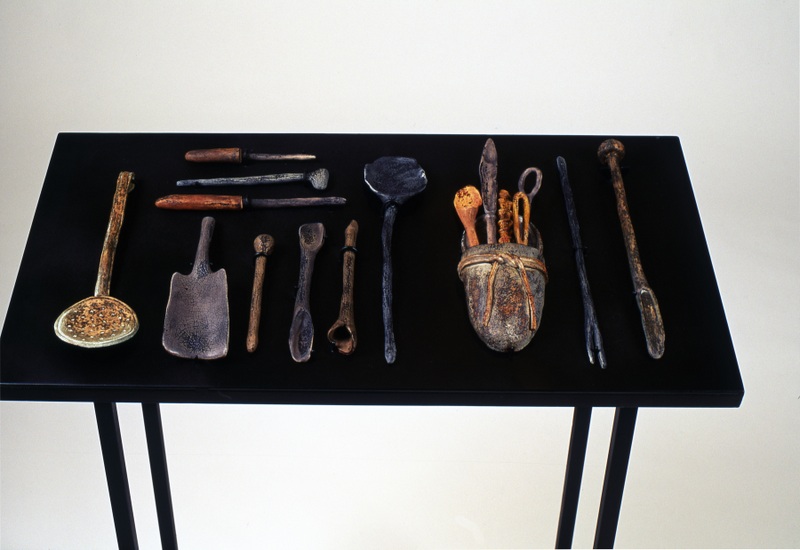 Jane Buyers, Pratica #1 (detail), 1993. Ceramic on steel table. 84 x 71 x 34 cm. Photo credit: Laura Arsie. Collection of Art Gallery of Woodstock.
Jane Buyers, Pratica #1 (detail), 1993. Ceramic on steel table. 84 x 71 x 34 cm. Photo credit: Laura Arsie. Collection of Art Gallery of Woodstock.
[youtube]http://www.youtube.com/watch?v=BBiN1BLV2cg[/youtube]
—Ann Ireland & Jane Buyers
—————————————————————
Jane Buyers is an artist originally from Toronto who lives in Elmira, Ontario with her partner, the playwright Don Druick. She is Professor Emerita in the Fine Arts Department at the University of Waterloo. Her work includes sculpture, drawing printmaking and commissioned public works. Jane has had numerous solo and group exhibitions in Canada as well as in the United States and Europe and her work is in many private and public collections. Jane was elected to the Royal Canadian Academy of Arts in 2002. A survey exhibition of her work from the past 30 years was held at the Kitchener-Waterloo Art Gallery January 18 through March 10, 2013 and will be touring to other venues. She is represented by Paul Petro Contemporary Art, Toronto.
Don Druick is an award winning playwright, translator & librettist, a baroque musician and a gardener and chef. In a career spanning more than 40 years, Druick’s plays have been produced on stage, radio and television in Canada, Europe, Japan, and the USA. His publications include play texts, translations and critical writings. His plays, WHERE IS KABUKI? and THROUGH THE EYES, have both been shortlisted for the Governor General’s Literary Awards. His current plays include GEORGEVILLE, WILDEST DREAMS, and a translation of Emmanuelle Roy’s play, LAZETTE. He lives in Elmira, a small Mennonite farming town near Waterloo, Ontario, with artist Jane Buyers.
 Ann Ireland is a Contributing Editor at Numéro Cinq. Hermost recent novel, The Blue Guitar, was published by Dundurn Press in early 2013. Her first novel, A Certain Mr. Takahashi, won the $50,000 Seal-Bantam First Novel Award and was made into a feature motion picture called The Pianist in 1991. Her second novel, The Instructor, was nominated for the Trillium Award and the Barnes and Noble’s Discover These New Writers Award, and Exile was shortlisted for the Governor-General’s Award and the Rogers/Writers Trust Award. She is a past president of PEN Canada and coordinates Ryerson University’s Chang School of Continuing Education, Writing Workshops department. She lives most of the time in Toronto and part of the time in Mexico.
Ann Ireland is a Contributing Editor at Numéro Cinq. Hermost recent novel, The Blue Guitar, was published by Dundurn Press in early 2013. Her first novel, A Certain Mr. Takahashi, won the $50,000 Seal-Bantam First Novel Award and was made into a feature motion picture called The Pianist in 1991. Her second novel, The Instructor, was nominated for the Trillium Award and the Barnes and Noble’s Discover These New Writers Award, and Exile was shortlisted for the Governor-General’s Award and the Rogers/Writers Trust Award. She is a past president of PEN Canada and coordinates Ryerson University’s Chang School of Continuing Education, Writing Workshops department. She lives most of the time in Toronto and part of the time in Mexico.

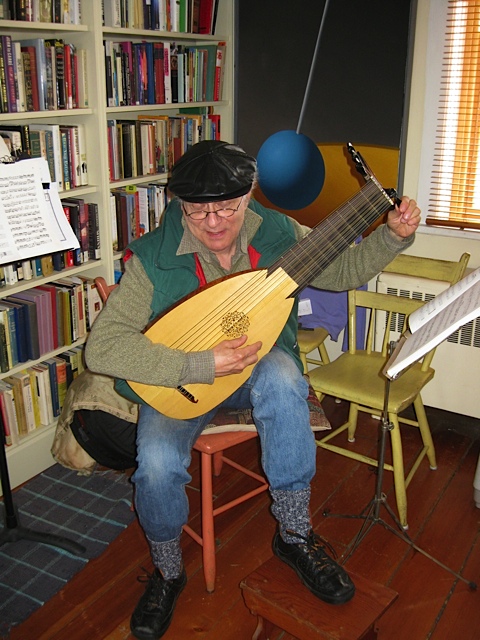
I’ve enjoyed reading this text so much … it brought back the sensations of my own journeys early on to Jane’s home in Elmira. Besides her visual art and writing practices, I know Jane as a gardener but not as a musician!